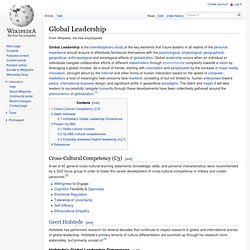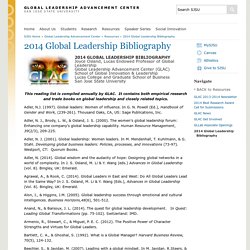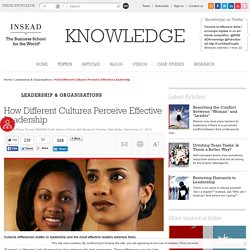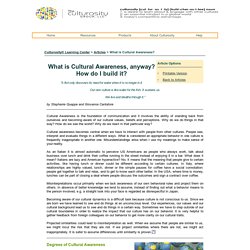

Eight Behaviors That Differentiate An Innovative Global Leader? The following blog post is an excerpt from the Innovative Leadership Workbook for Global Leaders by Maureen Metcalf, Steve Terrell and Ben Mitchell – Coming April 2014.

Globalization has so rapidly developed over the past 25 years to the point that a significant number of organizations operate today as if the entire world were a single market or entity, comprising many different, interconnected sub-markets, and crossing borders, cultures, time zones, and language differences. This high degree of interconnectedness, brought about through the impact and use of technology, melds with the chaos and continuous change of today’s business environment to create a highly dynamic, complex, borderless, multicultural context within which businesses must learn to operate or suffer the undesirable consequences of being left behind. Organizations are discovering that globalization demands that leaders master different skills than were required in the past.
Photo credit: www.flickr.com tellytom. Global Leadership. Cross-Cultural Competency (C3)[edit]

Global Leadership and Organizational Behavior Effectiveness Research Project. Cross-Cultural Competency (C3)[edit] A set of 40 general cross-cultural learning statements (knowledge, skills, and personal characteristics) were recommended by a DoD focus group in order to foster the career development of cross-cultural competence in military and civilian personnel.[2] Geert Hofstede[edit]

Global Leadership. Taxonomy of global leadership competencies. Global HR News: 12 competencies define a global leader. Research highlights innovative approaches for developing global leaders for successful globalization.

Despite the unprecedented scale and intensity of the globalization of organizations, few are well prepared for the talent demands required to successfully lead the business objectives behind globalization strategies. Developing a Global Mindset: The Relationship between an International Assignment and Cultural Intelligence. Global Leadership Advancement Center. 2014 GLOBAL LEADERSHIP BIBLIOGRAPHYJoyce Osland, Lucas Endowed Professor of Global LeadershipGlobal Leadership Advancement Center (GLAC)School of Global Innovation & LeadershipLucas College and Graduate School of BusinessSan Jose State University This reading list is compiled annually by GLAC.

It contains both empirical research and trade books on global leadership and closely related topics. Adler, N.J. (1997). Global leaders: Women of influence. In G. Adler, N. Adler, N. Adler, N. (2014). Agrawal, A., & Rook, C. (2014). Alon, I., & Higgins, J.M. (2005). Anand, N., & Barsoux, J. Armenio, R., Stewart, C., & Miguel, P. Bartlett, C. Beechler, S., & Javidan, M. (2007). Bennett, J. (2014). Bikson, T., Treverton, G., Moini, J., & Lindstrom, G. (2003). When Cultures Collide: Leading Across Cultures. Leadership Styles in Different Cultures: GLOBE Findings. Leadership Attributes: Universals and “Culturally Contingent” Before we explore the six culturally endorsed leadership dimensions, let’s return to the “attributes,” the many characteristics and behaviors that might be responsible for a leader’s effectiveness or lack of it.

Recall from my introductory article that the researchers imposed upon themselves very stringent requirements for saying that any attribute is “universally” agreed upon as positive or negative (click here). UNIVERSAL POSITIVES: The researchers were able to identify 22 attributes that are universally regarded as positive, i.e., as contributing to outstanding leadership. Few readers will be surprised by any attribute on this list – “trustworthy,” “motive arouser,” and “excellence oriented” are among the 22.
What is more significant is that, of these 22 attributes, 13 were found to have a strong statistical relationship with just three of the “primary leadership dimensions.” Here are a few others. How Different Cultures Perceive Effective Leadership. Cultural differences matter in leadership and the most effective leaders embrace them.

In a globalised work environment, having a multinational team is becoming the norm. Whether a leader is “Eastern” or “Western” will influence how they interact with their employees. Leadership Styles Around The World. Different cultures can have radically different leadership styles, and international organizations would do well to understand them.

British linguist Richard D. Lewis charted these differences in his book "When Cultures Collide," first published in 1996 and now in its third edition, and he teaches these insights in seminars with major corporate clients. From structured individualism in the U.S. to ringi-sho consensus in Japan, the charts seem intuitively correct, if not unilaterally true across a country. Lewis acknowledges the risks of dealing in stereotypes: "Determining national characteristics is treading a minefield of inaccurate assessment and surprising exception.
There is, however, such a thing as a national norm. " With permission from the author, we are posting 24 charts of leadership styles from his book, with a brief summary of his comments about each below: What is Cultural Awareness? How Do I Develop It? Cultural Awareness is the foundation of communication and it involves the ability of standing back from ourselves and becoming aware of our cultural values, beliefs and perceptions.

Why do we do things in that way? How do we see the world? Why do we react in that particular way? Cultural awareness becomes central when we have to interact with people from other cultures. Ultimate attribution error. The ultimate attribution error is a group-level attribution error that offers an explanation for how one person views different causes of negative and positive behavior in ingroup and outgroup members.[1] Ultimate attribution error is the tendency to internally attribute negative outgroup and positive ingroup behaviour and to externally attribute positive outgroup and negative ingroup behaviour.

So in other words, ultimate attribution error arises as a way to explain an outgroup's negative behaviour as flaws in their personality, and to explain an outgroup's positive behaviour as a result of chance or circumstance. It is also the belief that positive acts performed by ingroup members are as a result of their personality, whereas, if an ingroup member behaves negatively (which is believed to be rare), it is a result of situational factors.[2] Overview[edit]
Communicating Across Cultures. A Global Leader’s Guide to Managing Business Conduct. Managers working outside their home environments often find that their companies’ norms are inconsistent with practices followed by other businesses in the area. In response, many follow the time-honored advice given in the fourth century by the bishop of Milan to Augustine of Hippo: When in Rome, do as the Romans do.
But that’s a perilous approach. Consider the outrage in the United States when the media reported that BP oil rigs in the Gulf of Mexico lacked safeguards required on similar machinery in Norway and Brazil—even though the failed equipment in the Gulf met U.S. legal requirements. Or the worldwide outcry over working conditions at Foxconn in China after some employees committed suicide, although the company’s factories were arguably no worse than thousands of others nearby.
Kiss, Bow, or Shake Hands. Executive Planet. GlobalEDGE: Your source for Global Business Knowledge. Online Intercultural Resources. Country information. World Facts and Resources. World map with countries. Global Leadership Summit at London Business School. The rapid advance of technology in the digital age has had a profound impact on society, politics and the economy. Practicing Effectiveness in Global Leadership Activities. Effective Leadership in International Organizations. A Developmental Approach to Global Leadership. Global Leadership Development. Center for Strategic and International Studies. International Leadership Association. Perspectives_on_global_organizations. 2014 Best Companies at Global Leadership. Global Top 100 companies – 2014 update: PwC. The combined market capital of the world’s Top 100 companies has grown exponentially since 2009.. The most valuable publicly listed companies are from the technology, consumer services or health care sectors- and they are mostly US companies.
In terms of growth, technology and consumer services are the most improved sectors by market cap in the Top 100. In this report we have ranked the Top 100 global companies by market capitalisation and compared how the list has evolved from March 2009 to March 2014. We have identified the risers and the fallers, looked at sector dynamics and presented a view on how the global landscape has changed. Few Companies Actually Succeed at Going Global. We all like to learn from the best.
So when it comes to growth it’s tempting to take global high-performers like GE, IBM, Shell, or BMW as role models and look for opportunities outside the home markets. The trouble is that these global role models are much easier to admire than to imitate. Global Leadership & Computer-Mediated Communication Researcher.